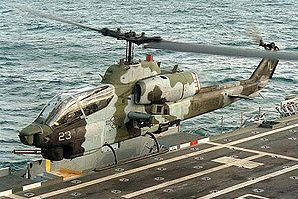
NEWSROOM
 |
NEWSROOM |
|
|
|
||||
|
|
||||
 |
The Bell AH-1 SuperCobra is a twin-engine attack helicopter based on the
US Army's AH-1 Cobra. The twin Cobra family includes the AH-1J SeaCobra,
the AH-1T Improved SeaCobra, and the AH-1W SuperCobra. The AH-1W is the
backbone of the United States Marine Corps's attack helicopter fleet,
but will be replaced in service by the AH-1Z Viper upgrade in the next
decade.
The AH-1 Cobra was developed in the mid-1960s as an interim gunship for
the U.S. Army for use in |
|||
|
The U.S. Marine
Corps was very interested in the AH-1G Cobra, but preferred a twin-engined
version for improved safety in over-water operations, and also wanted a
more potent turret-mounted weapon. At first, the Department of Defense
had balked at providing the Marines with a twin-engined version of the
Cobra, in the belief that commonality with Army AH-1Gs outweighed the
advantages of a different engine fit. However, the Marines won out and
awarded
The Marine Corps requested greater load carrying capability in high
temperatures for the Cobra in the 1970s.
In the early 1980s, the U.S. Marine Corps sought a new navalized
helicopter, but was denied funding to buy the AH-64 Apache by Congress
in 1981. The Marines in turn pursued a more powerful version of the
AH-1T. Other changes included modified fire control systems to carry and
fire AIM-9 Sidewinder and AGM-114 Hellfire missiles. The new version was
funded by Congress and received the AH-1W designation. At least 266 were
delivered. |
||||
|
The AH-1T+
demonstrator and AH-1W prototype was later tested with a new
experimental composite four blade main rotor system. The new system
offered better performance, reduced noise and improved battle damage
tolerance. Lacking a USMC contract,
The AH-1Z Viper features several design changes. The AH-1Z's two
redesigned wing stubs are longer with each adding a wing-tip station for
a missile such as the AIM-9 Sidewinder. Each wing has two other stations
for 70 mm (2.75 in) Hydra rocket pods, or AGM-114 Hellfire quad missile
launcher. The Longbow radar can be mounted on a wing tip station.
During the closing months of the
Marine Cobras took part in the invasion of
During the 1983 Marine multinational force operations off the coast of
During Operation Desert Shield in 1990, and Operation Desert Storm in
Jan-Feb 1991, Cobras and SeaCobras deployed to
Iranian AH-1J SeaCobras participated in air combat with Iraqi Mi-24s on
several separate occasions during the Iran?Iraq War. The results of
these engagements are disputed. One document cited that "Iranian AH-1Js
engaged Iraqi MI-8 Hip and MI-24 Hind helicopters. Unclassified sources
report that the Iranian AH-1 pilots achieved a 10:1 kill ratio over the
Iraqi helicopter pilots during these engagements (1:5). Additionally,
Iranian AH-1 and Iraqi fixed wing aircraft engagements also occurred.
Others claim that in the entire eight-year conflict, ten Iranian AH-1Js
were lost in combat, compared to six Iraqi Mi-24. The skirmishes are
described as fairly evenly matched in another source. Iranian AH-1Js are
still operating today and have undergone indigenous upgrade programs. In
1988, two Soviet MiG-23s shot down a pair of Iranian AH-1Js that had
strayed into western Afghan airspace.
Marine Cobras provided support for the
AH-1 Cobras continue to operate with the U.S. Marine Corps. USMC Cobras
were also used in operations throughout the 1990s. USMC Cobras have also
served in Operation Enduring Freedom in |
| ?AvStop Online Magazine Contact Us Return To News |